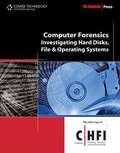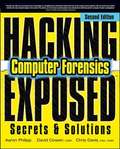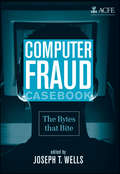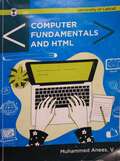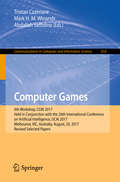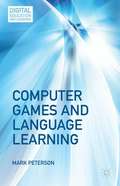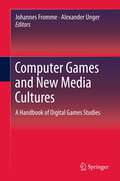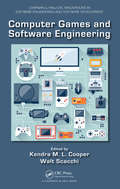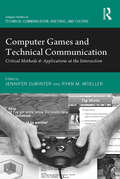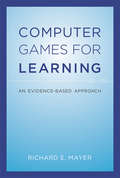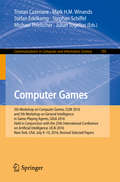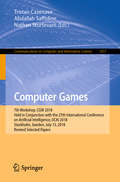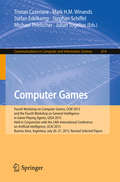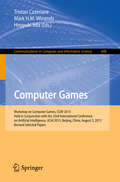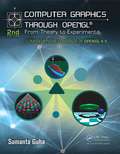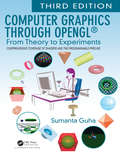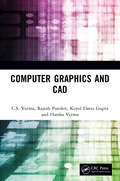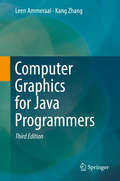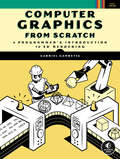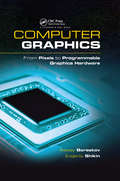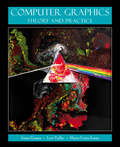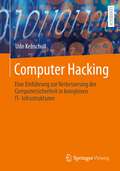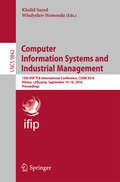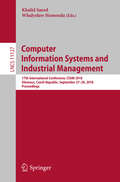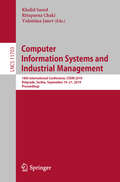- Table View
- List View
Computer Forensics: Investigating Hard Disks, File and Operating Systems:
by EC-CouncilThe text provides the knowledge and skills to identify, track, and prosecute the cyber-criminal. The series is comprised of five books covering a broad base of topics in Computer Hacking Forensic Investigation, designed to expose the reader to the process of detecting attacks and collecting evidence in a forensically sound manner with the intent to report crime and prevent future attacks.
Computer Forensics: Secrets and Solutions (Second Edition)
by David Cowen Aaron Philipp Chris Davis"Provides the right mix of practical how-to knowledge in a straightforward, informative fashion that ties it all the complex pieces together with real-world case studies. . . . Delivers the most valuable insight on the market. The authors cut to the chase of what people must understand to effectively perform computer forensic investigations. " --Brian H. Karney, COO, AccessData Corporation The latest strategies for investigating cyber-crime Identify and investigate computer criminals of all stripes with help from this fully updated. real-world resource. Hacking Exposed Computer Forensics, Second Edition explains how to construct a high-tech forensic lab, collect prosecutable evidence, discover e-mail and system file clues, track wireless activity, and recover obscured documents. Learn how to re-create an attacker's footsteps, communicate with counsel, prepare court-ready reports, and work through legal and organizational challenges. Case studies straight from today's headlines cover IP theft, mortgage fraud, employee misconduct, securities fraud, embezzlement, organized crime, and consumer fraud cases. Effectively uncover, capture, and prepare evidence for investigation Store and process collected data in a highly secure digital forensic lab Restore deleted documents, partitions, user activities, and file systems Analyze evidence gathered from Windows, Linux, and Macintosh systems Use the latest Web and client-based e-mail tools to extract relevant artifacts Overcome the hacker's anti-forensic, encryption, and obscurity techniques Unlock clues stored in cell phones, PDAs, and Windows Mobile devices Prepare legal documents that will hold up to judicial and defense scrutiny
Computer Fraud Casebook: The Bytes that Bite
by Joseph T. WellsThis one-of-a-kind collection consists of actual cases written by fraud examiners out in the field. These cases were hand selected from hundreds of submissions and together form a comprehensive picture of the many types of computer fraud how they are investigated, across industries and throughout the world. Topics included are email fraud, on-line auction fraud, security breaches, counterfeiting, and others.
Computer Fundamentals And HTML - Calicut University
by Muhammed Anees. V"Computer Fundamentals and HTML" authored by Muhammed Anees. V, a distinguished faculty member at the Department of Computer Science, Cochin University of Science and Technology, stands as a comprehensive guide published by The Calicut University Central Co-Operative Stores Ltd in 2022. Tailored for students enrolled in diverse BSc courses, this book aligns seamlessly with the curriculum set by the esteemed University of Calicut. Its content spans two significant domains: the foundational aspects of computing, covering hardware, software, computer organization, number systems, Boolean algebra, problem-solving methodologies, and algorithms; and a detailed exploration of HTML, encompassing the rudiments of web design, an overview of HTML5, advanced HTML concepts, and CSS. By prioritizing simplicity, clarity, and conciseness, the book adeptly elucidates intricate concepts, supplemented by practical applications and examples. Notably, it diligently references its information sources and encourages constructive feedback from its readers, fostering an environment conducive to continuous improvement and enhanced learning experiences.
Computer Games
by Tristan Cazenave Mark H.M. Winands Abdallah SaffidineThis book constitutes revised selected papers from the 6th Workshop on Computer Games, CGW 2017, held in conjunction with the 26th International Conference on Artificial Intelligence, IJCAI 2017, in Melbourne, Australia, in August 2017. The 12 full papers presented in this volume were carefully reviewed and selected from 18 submissions. They cover a wide range of topics related to computer games; discussing six abstract games: Chinese Checkers, Chinese Dark Chess, Hex, Othello, Poker, and SameGame.
Computer Games And Language Learning
by Mark PetersonA comprehensive and accessible overview for language educators, researchers, and students, this book examines the relationship between technological innovation and development in the field of computer-assisted language learning, exploring relevant theories and providing practical evidence about the use of computer games in language learning.
Computer Games and New Media Cultures: A Handbook of Digital Games Studies
by Alexander Unger Johannes FrommeDigital gaming is today a significant economic phenomenon as well as being an intrinsic part of a convergent media culture in postmodern societies. Its ubiquity, as well as the sheer volume of hours young people spend gaming, should make it ripe for urgent academic enquiry, yet the subject was a research backwater until the turn of the millennium. Even today, as tens of millions of young people spend their waking hours manipulating avatars and gaming characters on computer screens, the subject is still treated with scepticism in some academic circles. This handbook aims to reflect the relevance and value of studying digital games, now the subject of a growing number of studies, surveys, conferences and publications. As an overview of the current state of research into digital gaming, the 42 papers included in this handbook focus on the social and cultural relevance of gaming. In doing so, they provide an alternative perspective to one-dimensional studies of gaming, whose agendas do not include cultural factors. The contributions, which range from theoretical approaches to empirical studies, cover various topics including analyses of games themselves, the player-game interaction, and the social context of gaming. In addition, the educational aspects of games and gaming are treated in a discrete section. With material on non-commercial gaming trends such as 'modding', and a multinational group of authors from eleven nations, the handbook is a vital publication demonstrating that new media cultures are far more complex and diverse than commonly assumed in a debate dominated by concerns over violent content.
Computer Games and Software Engineering (Chapman & Hall/CRC Innovations in Software Engineering and Software Development Series)
by Kendra M. L. Cooper Walt ScacchiComputer games represent a significant software application domain for innovative research in software engineering techniques and technologies. Game developers, whether focusing on entertainment-market opportunities or game-based applications in non-entertainment domains, thus share a common interest with software engineers and developers on how to
Computer Games and Technical Communication: Critical Methods and Applications at the Intersection (Routledge Studies in Technical Communication, Rhetoric, and Culture)
by Jennifer deWinter Ryan M. MoellerTaking as its point of departure the fundamental observation that games are both technical and symbolic, this collection investigates the multiple intersections between the study of computer games and the discipline of technical and professional writing. Divided into five parts, Computer Games and Technical Communication engages with questions related to workplace communities and gamic simulations; industry documentation; manuals, gameplay, and ethics; training, testing, and number crunching; and the work of games and gamifying work. In that computer games rely on a complex combination of written, verbal, visual, algorithmic, audio, and kinesthetic means to convey information, technical and professional writing scholars are uniquely poised to investigate the intersection between the technical and symbolic aspects of the computer game complex. The contributors to this volume bring to bear the analytic tools of the field to interpret the roles of communication, production, and consumption in this increasingly ubiquitous technical and symbolic medium.
Computer Games for Learning: An Evidence-Based Approach (The\mit Press Ser.)
by Richard E. MayerA comprehensive and up-to-date investigation of what research shows about the educational value of computer games for learning. Many strong claims are made for the educational value of computer games, but there is a need for systematic examination of the research evidence that might support such claims. This book fills that need by providing, a comprehensive and up-to-date investigation of what research shows about learning with computer games. Computer Games for Learning describes three genres of game research: the value-added approach, which compares the learning outcomes of students who learn with a base version of a game to those of students who learn with the base version plus an additional feature; the cognitive consequences approach, which compares learning outcomes of students who play an off-the-shelf computer game for extended periods to those of students who do not; and the media comparative approach, which compares the learning outcomes of students who learn material by playing a game to those of students who learn the same material using conventional media. After introductory chapters that describe the rationale and goals of learning game research as well as the relevance of cognitive science to learning with games, the book offers examples of research in all three genres conducted by the author and his colleagues at the University of California, Santa Barbara; meta-analyses of published research; and suggestions for future research in the field. The book is essential reading for researchers and students of educational games, instructional designers, learning-game developers, and anyone who wants to know what the research has to say about the educational effectiveness of computer games.
Computer Games: 5th Workshop on Computer Games, CGW 2016, and 5th Workshop on General Intelligence in Game-Playing Agents, GIGA 2016, Held in Conjunction with the 25th International Conference on Artificial Intelligence, IJCAI 2016, New York, USA, July 9-10, 2016, Revised Selected Papers (Communications in Computer and Information Science #705)
by Tristan Cazenave Mark H.M. Winands Stefan Edelkamp Stephan Schiffel Michael Thielscher Julian TogeliusThis book contains the papers of the 6th Computers and Games Conference (CG 2008)held in Beijing, China. The conference took place from September 29 th to October 1, 2008 in conjunction with the 13 International Computer Games th Championship and the 16 World Computer Chess Championship. The Computers and Games conference series is a major international forum for researchers and developers interested in all aspects of arti?cial intelligence and computer game playing. The Beijing conference was de?nitively charact- ized by fresh ideas for a large variety of games. Earlier conferences took place in Tsukuba, Japan (1998), Hamamatsu, Japan (2000), Edmonton, Canada, (2002), Ramat-Gan, Israel (2004), and Turin, Italy (2006). The Programme Committee (PC) received 40 submissions. Each paper was initiallysenttoatleasttworeferees. Ifcon?ictingviewsonapaperwerereported, itwassenttoanadditionalreferee. Outofthe40submissions, onewaswithdrawn before the ?nal decisions weremade. With the help of many referees (listed after the preface), the PC accepted 24 papers for presentation at the conference and publication in these proceedings. Theabove-mentionedsetof24paperscoversawiderangeofcomputergames. Twelve of the games are played in practice by human players, viz. , Go, We- ern Chess, Chinese Chess (Xiangqi), Japanese Chess (Shogi), Amazons, Chinese Checkers, Hearts, Hex, Lines of Action, Othello, Siguo, and Spades. Moreover, there was onepuzzle, viz. , SameGame, andtwo theoreticalgames, viz. , Synch- nized Domineering and multi-player Can t Stop. Thepapersdealwithmanydi?erentresearchtopicsincludingcognition, c- binatorial game theory, search, knowledge representation, and optimization. We hope that the readerswill enjoy the researche?orts of the authors. Below we provide a brief outline of the 24 contributions, in the order in which they are printed in the book
Computer Games: 7th Workshop, CGW 2018, Held in Conjunction with the 27th International Conference on Artificial Intelligence, IJCAI 2018, Stockholm, Sweden, July 13, 2018, Revised Selected Papers (Communications in Computer and Information Science #1017)
by Tristan Cazenave Abdallah Saffidine Nathan SturtevantThis book constitutes revised selected papers from the 7th Workshop on Computer Games, CGW 2018, held in conjunction with the 27th International Conference on Artificial Intelligence, IJCAI 2018 in Stockholm, Sweden, in July 2018.The 8 full papers presented in this volume were carefully reviewed and selected from 15 submissions. They cover a wide range of topics related to video games; general game playing.- machine learning and Monte Carlo tree search.
Computer Games: Fourth Workshop on Computer Games, CGW 2015, and the Fourth Workshop on General Intelligence in Game-Playing Agents, GIGA 2015, Held in Conjunction with the 24th International Conference on Artificial Intelligence, IJCAI 2015, Buenos Aires, Argentina, July 26-27, 2015, Revised Selected Papers (Communications in Computer and Information Science #614)
by Tristan Cazenave Mark H.M. Winands Stefan Edelkamp Stephan Schiffel Michael Thielscher Julian TogeliusThis book constitutes the refereed proceedings of the Fourth Computer Games Workshop, CGW 2015, and the Fourth Workshop on General Intelligence in Game-Playing Agents, GIGA 2015, held in conjunction with the 24th International Conference on Artificial Intelligence, IJCAI 2015, Buenos Aires, Argentina, in July 2015. The 12 revised full papers presented were carefully reviewed and selected from 27 submissions. The papers address all aspects of artificial intelligence and computer game playing. They discuss topics such as Monte-Carlo methods; heuristic search; board games; card games; video games; perfect and imperfect information games; puzzles and single player games; multi-player games; combinatorial game theory; applications; computational creativity; computational game theory; evaluation and analysis; game design; knowledge representation; machine learning; multi-agent systems; opponent modeling; planning; reasoning; search.
Computer Games: Workshop on Computer Games, CGW 2013, Held in Conjunction with the 23rd International Conference on Artificial Intelligence, IJCAI 2013, Beijing, China, August 3, 2013, Revised Selected Papers (Communications in Computer and Information Science #408)
by Tristan Cazenave Mark H.M. Winands Hiroyuki IidaThis book constitutes the refereed proceedings of the Computer Games Workshop, CGW 2013, held in Beijing, China, in August 2013, in conjunction with the Twenty-third International Conference on Artificial Intelligence, IJCAI 2013. The 9 revised full papers presented were carefully reviewed and selected from 15 submissions. The papers cover a wide range of topics related to computer games. They discuss six games that are played by humans in practice: Chess, Domineering, Chinese Checkers, Go, Goofspiel, and Tzaar. Moreover, there are papers about the Sliding Tile Puzzle, an application, namely, Cooperative Path-Finding Problems, and on general game playing.
Computer Graphics Through OpenGL: From Theory to Experiments
by Sumanta GuhaFrom geometric primitives to animation to 3D modeling to lighting, shading, and texturing, Computer Graphics Through OpenGL: From Theory to Experiments, Second Edition presents a comprehensive introduction to computer graphics that uses an active learning style to teach key concepts. Equally emphasizing theory and practice, the book provides an und
Computer Graphics Through OpenGL®: From Theory to Experiments
by Sumanta GuhaCOMPREHENSIVE COVERAGE OF SHADERS AND THE PROGRAMMABLE PIPELINE <P><P> From geometric primitives to animation to 3D modeling to lighting, shading and texturing, Computer Graphics Through OpenGL®: From Theory to Experiments is a comprehensive introduction to computer graphics which uses an active learning style to teach key concepts. Equally emphasizing theory and practice, the book provides an understanding not only of the principles of 3D computer graphics, but also the use of the OpenGL® Application Programming Interface (API) to code 3D scenes and animation, including games and movies. The undergraduate core of the book takes the student from zero knowledge of computer graphics to a mastery of the fundamental concepts with the ability to code applications using fourth-generation OpenGL®. The remaining chapters explore more advanced topics, including the structure of curves and surfaces, applications of projective spaces and transformations and the implementation of graphics pipelines. This book can be used for introductory undergraduate computer graphics courses over one to two semesters. The careful exposition style attempting to explain each concept in the simplest terms possible should appeal to the self-study student as well. <P><P> Features <br>• Covers the foundations of 3D computer graphics, including animation, visual techniques and 3D modeling• Comprehensive coverage of OpenGL® 4.x, including the GLSL and vertex, fragment, tessellation and geometry shaders• Includes 180 programs with 270 experiments based on them• Contains 750 exercises, 110 worked examples, and 700 four-color illustrations• Requires no previous knowledge of computer graphics• Balances theory with programming practice using a hands-on interactive approach to explain the underlying concepts
Computer Graphics and CAD
by C.S. Verma Rajesh Purohit Koyel Datta Gupta Harsha VermaThis book discusses the fundamental concepts shaping modern design and visualization definition through Computer Graphics and the intricacies of CAD modelling practices.From 3D object representation to surface modelling and solid techniques, subsequent chapters offer a comprehensive exploration of advanced topics essential for geometric modelling. With a focus on industry applications and practical examples, readers acquire the skills needed to navigate the complexities of animation systems and finite element analysis, ensuring a holistic understanding of CAD and Computer Graphics. Whether you're a novice or seasoned professional, this guide provides a rich blend of theory and practice, accompanied by a wealth of solved and unsolved problems for hands-on learning.Print edition not for sale in South Asia (India, Sri Lanka, Nepal, Bangladesh, Pakistan or Bhutan)
Computer Graphics for Java Programmers
by Leen Ammeraal Kang ZhangThis third edition covers fundamental concepts in creating and manipulating 2D and 3D graphical objects, including topics from classic graphics algorithms to color and shading models. It maintains the style of the two previous editions, teaching each graphics topic in a sequence of concepts, mathematics, algorithms, optimization techniques, and Java coding. Completely revised and updated according to years of classroom teaching, the third edition of this highly popular textbook contains a large number of ready-to-run Java programs and an algorithm animation and demonstration open-source software also in Java. It includes exercises and examples making it ideal for classroom use or self-study, and provides a perfect foundation for programming computer graphics using Java. Undergraduate and graduate students majoring specifically in computer science, computer engineering, electronic engineering, information systems, and related disciplines will use this textbook for their courses. Professionals and industrial practitioners who wish to learn and explore basic computer graphics techniques will also find this book a valuable resource.
Computer Graphics from Scratch: A Programmer's Introduction to 3D Rendering
by Gabriel GambettaComputer Graphics from Scratch demystifies the algorithms used in modern graphics software and guides beginners through building photorealistic 3D renders.Computer graphics programming books are often math-heavy and intimidating for newcomers. Not this one. Computer Graphics from Scratch takes a simpler approach by keeping the math to a minimum and focusing on only one aspect of computer graphics, 3D rendering. You&’ll build two complete, fully functional renderers: a raytracer, which simulates rays of light as they bounce off objects, and a rasterizer, which converts 3D models into 2D pixels. As you progress you&’ll learn how to create realistic reflections and shadows, and how to render a scene from any point of view. Pseudocode examples throughout make it easy to write your renderers in any language, and links to live JavaScript demos of each algorithm invite you to explore further on your own.Learn how to:Use perspective projection to draw 3D objects on a 2D planeSimulate the way rays of light interact with surfacesAdd mirror-like reflections and cast shadows to objectsRender a scene from any camera position using clipping planesUse flat, Gouraud, and Phong shading to mimic real surface lightingPaint texture details onto basic shapes to create realistic-looking objects Whether you&’re an aspiring graphics engineer or a novice programmer curious about how graphics algorithms work, Gabriel Gambetta&’s simple, clear explanations will quickly put computer graphics concepts and rendering techniques within your reach. All you need is basic coding knowledge and high school math. Computer Graphics from Scratch will cover the rest.
Computer Graphics: From Pixels to Programmable Graphics Hardware (Chapman And Hall/crc Computer Graphics, Geometric Modeling, And Animation Ser. #3)
by Alexey Boreskov Evgeniy ShikinComplete Coverage of the Current Practice of Computer GraphicsComputer Graphics: From Pixels to Programmable Graphics Hardware explores all major areas of modern computer graphics, starting from basic mathematics and algorithms and concluding with OpenGL and real-time graphics. It gives students a firm foundation in today's high-performance graphic
Computer Graphics: Theory and Practice
by Jonas Gomes Luiz Velho Mario Costa SousaComputer Graphics: Theory and Practice provides a complete and integrated introduction to this area. The book only requires basic knowledge of calculus and linear algebra, making it an accessible introductory text for students. It focuses on conceptual aspects of computer graphics, covering fundamental mathematical theories and models and the inher
Computer Hacking: Eine Einführung zur Verbesserung der Computersicherheit in komplexen IT-Infrastrukturen
by Udo KebschullTechnische Maßnahmen, die es Cyberangreifern schwer machen, dienen zur Abschreckung, weil Hacker immer nur so hoch springen, wie sie müssen. Bei komplexen und vor allem sicherheitsrelevanten IT-Infrastrukturen reichen diese technischen Maßnahmen allein jedoch oft nicht aus.Dieses Lehrbuch betrachtet alle Aspekte der IT-Sicherheit und effektive Maßnahmen, um Angriffe zu detektieren und sich erfolgreich dagegen zu wehren. Es behandelt allgemeine Angriffsmechanismen und Angriffsszenarien, die von Angreifern angewendet werden. Dabei soll klar werden, dass es nicht ausreichend ist, Firewall-Regeln sauber zu konfigurieren oder die aktuellsten Patches einzuspielen. Vielmehr muss ein ganzheitlicher Ansatz gewählt werden, der Nutzende einschließt (Awareness) und funktionierende Prozesse für den Fall eines konkreten Angriffs etabliert. Das Buch zeigt, wo die Schwachstellen liegen, wie man sie schließt, wie man Angriffe erkennt und wie man sie erfolgreich abwehrt.
Computer Information Systems and Industrial Management: 15th IFIP TC8 International Conference, CISIM 2016, Vilnius, Lithuania, September 14-16, 2016, Proceedings (Lecture Notes in Computer Science #9842)
by Khalid Saeed Władysław HomendaThis book constitutes the proceedings of the 15th IFIP TC8 International Conference on Computer Information Systems and Industrial Management, CISIM 2016, held in Vilnius, Lithuania, in September 2016. The 63 regular papers presented together with 1 inivted paper and 5 keynotes in this volume were carefully reviewed and selected from about 89 submissions. The main topics covered are rough set methods for big data analytics; images, visualization, classification; optimization, tuning; scheduling in manufacturing and other applications; algorithms; decisions; intelligent distributed systems; and biometrics, identification, security.
Computer Information Systems and Industrial Management: 17th International Conference, CISIM 2018, Olomouc, Czech Republic, September 27-29, 2018, Proceedings (Lecture Notes in Computer Science #11127)
by Khalid Saeed Władysław HomendaThis book constitutes the proceedings of the 17th International Conference on Computer Information Systems and Industrial Management Applications, CISIM 2018, held in Olomouc, Czech Republic, in September 2018. The 42 full papers presented together with 4 keynotes were carefully reviewed and selected from 69 submissions. The main topics covered by the chapters in this book are biometrics, security systems, multimedia, classification and clustering, and industrial management. Besides these, the reader will find interesting papers on computer information systems as applied to wireless networks, computer graphics, and intelligent systems. The papers are organized in the following topical sections: biometrics and pattern recognition applications; computer information systems; industrial management and other applications; machine learning and high performance computing; modelling and optimization; and various aspects of computer security.
Computer Information Systems and Industrial Management: 18th International Conference, CISIM 2019, Belgrade, Serbia, September 19–21, 2019, Proceedings (Lecture Notes in Computer Science #11703)
by Khalid Saeed Rituparna Chaki Valentina JanevThis book constitutes the proceedings of the 18th International Conference on Computer Information Systems and Industrial Management Applications, CISIM 2019, held in Belgrade, Serbia, in September 2019. The 43 full papers presented together with 3 abstracts of keynotes were carefully reviewed and selected from 70 submissions. The main topics covered by the chapters in this book are biometrics, security systems, multimedia, classification and clustering, industrial management. Besides these, the reader will find interesting papers on computer information systems as applied to wireless networks, computer graphics, and intelligent systems. The papers are organized in the following topical sections: biometrics and pattern recognition applications; computer information systems; industrial management and other applications; machine learning and high performance computing; modelling and optimization; various aspects of computer security.
